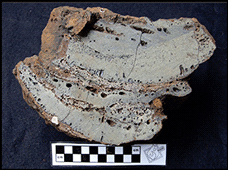Crossref Citations
This article has been cited by the following publications. This list is generated based on data provided by
Crossref.
Vodyasov, Evgeny V.
Zaitceva, Olga V.
Vavulin, Mikhail V.
and
Pushkarev, Andrei A.
2020.
The earliest box-shaped iron smelting furnaces in Asia: New data from Southern Siberia.
Journal of Archaeological Science: Reports,
Vol. 31,
Issue. ,
p.
102383.
Leroy, Stéphanie
Bauvais, Sylvain
Delqué-Količ, Emmanuelle
Hendrickson, Mitch
Josso, Nicolas
Dumoulin, Jean-Pascal
and
Soutif, Dominique
2020.
First experimental reconstruction of an Angkorian iron furnace (13th–14th centuries CE): Archaeological and archaeometric implications.
Journal of Archaeological Science: Reports,
Vol. 34,
Issue. ,
p.
102592.
Hendrickson, Mitch
and
Leroy, Stéphanie
2020.
Sparks and needles: Seeking catalysts of state expansions, a case study of technological interaction at Angkor, Cambodia (9th to 13th centuries CE).
Journal of Anthropological Archaeology,
Vol. 57,
Issue. ,
p.
101141.
Grave, Peter
Kealhofer, Lisa
Stark, Miriam T.
Ea, Darith
Chhay, Rachna
Marsh, Ben
Phon, Kaseka
Sugiyama, Hiroshi
Tabata, Yukitsugu
Sato, Yuni
Keo Sovannara, Sok
Chhay, Visoth
and
Veerawan, Sutee
2021.
Angkorian Khmer stoneware: production and provenance.
Journal of Archaeological Science: Reports,
Vol. 40,
Issue. ,
p.
103231.
Cai, Shuhui
Doctor, Rashida
Tauxe, Lisa
Hendrickson, Mitch
Hua, Quan
Leroy, Stéphanie
and
Phon, Kaseka
2021.
Archaeomagnetic results from Cambodia in Southeast Asia: Evidence for possible low-latitude flux expulsion.
Proceedings of the National Academy of Sciences,
Vol. 118,
Issue. 11,
Suryatman
Triwurjani, RR
Adhityatama, Shinatria
Bulbeck, David
Yurnaldi, Dida
Murdihastomo, Ashar
Wahyudiono, Joko
Abdullah
and
Dimas Khoiru Dhony, Muslim
2021.
Flaking stone activity in the tradition of iron smelting from the 8th to 17th centuries AD in the Matano region, South Sulawesi, Indonesia.
Journal of Archaeological Science: Reports,
Vol. 36,
Issue. ,
p.
102817.
Grave, Peter
Kealhofer, Lisa
Phon, Kaseka
Heng, Piphal
Stark, Miriam T.
Marsh, Ben
Ea, Darith
Chhay, Rachna
and
Marriner, Gary P.
2021.
Centralized power/decentralized production? Angkorian stoneware and the southern production complex of Cheung Ek, Cambodia.
Journal of Archaeological Science,
Vol. 125,
Issue. ,
p.
105270.
Hendrickson, Mitch
Leroy, Stéphanie
Castillo, Cristina
Hua, Quan
Vega, Enrique
and
Phon, Kaseka
2022.
Forging empire: Angkorian iron smelting, community and ritual practice at Tonle Bak—CORRIGENDUM.
Antiquity,
Vol. 96,
Issue. 387,
p.
799.
Khamsiri, Sutthikan
Venunan, Pira
Khaokheiw, Chawalit
Silapanth, Praon
Banron, Sirittha
and
Pailoplee, Santi
2022.
Late iron-smelting production of Angkor Highland, metallurgical site at Buriram Province, northeastern Thailand: A view from luminescence dating.
Archaeological Research in Asia,
Vol. 31,
Issue. ,
p.
100395.
Harris, Andrew
Tin, Tina
Chhay, Rachna
and
Vitou, Phirom
2023.
Broken Buddhas, burials, and sanctuary-adjacent sanctuaries: the ancestral animist archaeologies of Angkor’s ancient places and things.
World Archaeology,
Vol. 55,
Issue. 2,
p.
167.
Kupczak, Krzysztof
Warchulski, Rafał
Gawęda, Aleksandra
and
Janiec, Jan
2024.
Bloomery iron production in the Holy Cross Mountains (Poland) area during the Roman period: conditions during the metallurgical process and their uniformity between locations.
Heritage Science,
Vol. 12,
Issue. 1,
Pryce, T.O.
and
Willis, Anna
2025.
Southeast Asian mainland archaeological science 1964–2034: Multiscalar relations between individuals, communities and neighbouring populations during the Neolithic, Bronze and Iron Ages (early-3rd mill. BC to late-1st mill. AD).
Journal of Archaeological Science,
Vol. 176,
Issue. ,
p.
106154.
